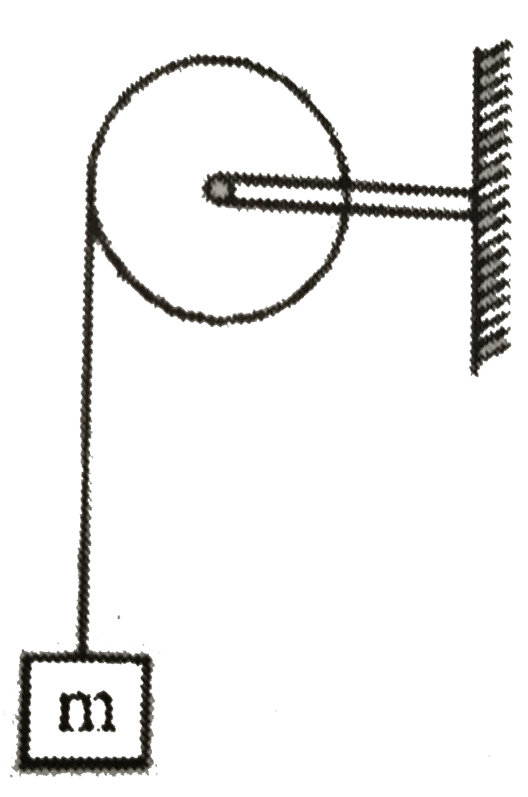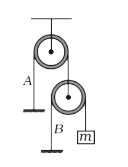A uniform disc of radius R and mass M is free to rotate about a fixed horizontal axis perpendicular to its plane and passing through its centre. A string is wrapped over its rim and a block of mass m is attached to the free end of the string. The block is released from rest. If string does not slip on the rim then find the acceleration of the block. Neglect the mass of the string.
To solve the problem, we will analyze the forces acting on the block and the torque acting on the disc. We will use Newton's second law and the rotational analog for the disc.
1. Identify the System:
We have a uniform disc of mass M and radius R that can rotate about a fixed axis. A block of mass m is attached to a string wrapped around the rim of the disc.
2. Define Variables:
- Let a be the linear acceleration of the block.
- Let α be the angular acceleration of the disc.
- The tension in the string is T.
3. Relate Linear and Angular Acceleration:
Since the string does not slip on the rim of the disc, the linear acceleration a of the block is related to the angular acceleration α of the disc by the equation:
a=Rα
4. Apply Newton's Second Law to the Block:
The forces acting on the block are the gravitational force mg acting downwards and the tension T acting upwards. According to Newton's second law:
mg−T=ma(1)
5. Apply Torque Equation to the Disc:
The torque τ caused by the tension T on the disc is given by:
τ=T⋅R
This torque is also equal to the moment of inertia I of the disc multiplied by its angular acceleration α:
T⋅R=Iα(2)
For a uniform disc, the moment of inertia I is:
I=12MR2
Substituting this into equation (2):
T⋅R=12MR2α
6. Substituting α:
From step 3, we know that α=aR. Substituting this into the torque equation gives:
T⋅R=12MR2⋅aR
Simplifying this:
T⋅R=12MRa
Dividing both sides by R:
T=12Ma(3)
7. Substituting T into the Block's Equation:
Now substitute equation (3) into equation (1):
mg−12Ma=ma
Rearranging gives:
mg=ma+12Ma
Factoring out a:
mg=a(m+12M)
Solving for a:
a=mgm+12M
Final Result:
The acceleration of the block is:
a=mgm+12M
We have a uniform disc of mass M and radius R that can rotate about a fixed axis. A block of mass m is attached to a string wrapped around the rim of the disc.
- Let a be the linear acceleration of the block.
- Let α be the angular acceleration of the disc.
- The tension in the string is T.
Since the string does not slip on the rim of the disc, the linear acceleration a of the block is related to the angular acceleration α of the disc by the equation:
a=Rα
The forces acting on the block are the gravitational force mg acting downwards and the tension T acting upwards. According to Newton's second law:
mg−T=ma(1)
The torque τ caused by the tension T on the disc is given by:
τ=T⋅R
This torque is also equal to the moment of inertia I of the disc multiplied by its angular acceleration α:
T⋅R=Iα(2)
For a uniform disc, the moment of inertia I is:
I=12MR2
Substituting this into equation (2):
T⋅R=12MR2α
From step 3, we know that α=aR. Substituting this into the torque equation gives:
T⋅R=12MR2⋅aR
Simplifying this:
T⋅R=12MRa
Dividing both sides by R:
T=12Ma(3)
Now substitute equation (3) into equation (1):
mg−12Ma=ma
Rearranging gives:
mg=ma+12Ma
Factoring out a:
mg=a(m+12M)
Solving for a:
a=mgm+12M
The acceleration of the block is:
a=mgm+12M
Similar Questions
A disc of mass m and radius r is free to rotate about its centre as shown in the figure. A string is wrapped over its rim and a block of mass m is attached to the free end of the string. The system is released from rest. The speed of the block as it descends through a height h, is :-
 View Solution
View SolutionA wheel of moment of inertia I and radius r is free to rotate about its centre as shown in figure. A string is wrapped over its rim and a block of mass m is attached to the free end of the string. The system is released from rest. Find the speed of the block as it descends through a height h.
 View Solution
View SolutionA uniform disc of radius R and mass M is free to rotate only about its axis. A string is wrapped over its rim and a body of mass m is tied to the free end of the string as shown in the figure. The body is released from rest. Then the acceleration of the body is
 View Solution
View SolutionA uniform disc of radius R and mass M is free to rotate only about its axis. A string is wrapped over its rim and a body of mass m is tied to the free end of the string as shown in the figure. The body is released from rest. Then the acceleration of the body is
 View Solution
View SolutionThe block of mass m is at rest. Find the tension in the string A .
 View Solution
View SolutionCircular disc of mass 2 kg and radius 1 m is rotating about an axis perpendicular to its plane and passing through its centre of mass with a rotational kinetic energy of 8 J. The angular momentum is (Js) is
View SolutionA uniformly thick wheel with moment of inertia I and radius R is free to rotate about its centre of mass (see fig). A massless string is wrapped over its rim and two blocks of masses m1andm2(m1>m2) are attached to the ends of the string. The system is released from rest. The angular speed of the wheel when m1 descents by a distance h is :
 View Solution
View SolutionA disc of radius R is pivoted at its rim. The period for small oscillations about an axis perpendicular to the plane of disc is
View SolutionA block of mass m is attached at the end of an inextensible string which is wound over a rough pulley of mass M and radius R figure a. Assume the string does not slide over the pulley. Find the acceleration of the block when released.
View SolutionA uniform disc of radius a and mass m, is rotating freely with angular speed ω in a horizontal plane about a smooth fixed vertical axis through its centre. A particle, also of mass m, is suddenly attached to the rim of the disc of the disc and rotates with it. The new angular speed is
View Solution
